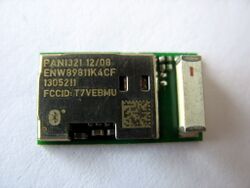Difference between revisions of "Protocol decoder:Pan1321"
Jump to navigation
Jump to search
Uwe Hermann (talk | contribs) m |
Uwe Hermann (talk | contribs) m |
||
| (2 intermediate revisions by the same user not shown) | |||
| Line 3: | Line 3: | ||
| name = Panasonic PAN1321 | | name = Panasonic PAN1321 | ||
| description = Bluetooth RF module with Serial Port Profile (SPP) | | description = Bluetooth RF module with Serial Port Profile (SPP) | ||
| status = | | status = supported | ||
| license = GPLv2+ | | license = GPLv2+ | ||
| source_code_dir = pan1321 | | source_code_dir = pan1321 | ||
| Line 11: | Line 11: | ||
| probes = — | | probes = — | ||
| optional_probes = — | | optional_probes = — | ||
| options = — | |||
}} | }} | ||
| Line 45: | Line 46: | ||
File:Panasonic pan1321 top.jpg|<small>PAN1321, top</small> | File:Panasonic pan1321 top.jpg|<small>PAN1321, top</small> | ||
File:Panasonic pan1321 bottom.jpg|<small>PAN1321, bottom</small> | File:Panasonic pan1321 bottom.jpg|<small>PAN1321, bottom</small> | ||
File:Pan1321 open.jpg|<small>PCB</small> | |||
</gallery> | </gallery> | ||
Latest revision as of 23:05, 2 April 2015
 | |
| Name | Panasonic PAN1321 |
|---|---|
| Description | Bluetooth RF module with Serial Port Profile (SPP) |
| Status | supported |
| License | GPLv2+ |
| Source code | decoders/pan1321 |
| Input | uart |
| Output | pan1321 |
| Probes | — |
| Optional probes | — |
| Options | — |
The pan1321 protocol decoder supports the Panasonic PAN1321 Bluetooth module (serial port profile, SPP) protocol.
Hardware
PAN1321
The uart/panasonic_pan1321 directory in sigrok-dumps contains a set of example captures of the communication with a Panasonic PAN1321.
The logic analyzer used was a ChronoVu LA8 (at 500kHz):
Probe setup:
| Probe | PAN1321 |
|---|---|
| 0 (green) | TX |
| 1 (orange) | RX |
Photos:
Protocol
The device can be controlled via a UART connection (RX/TX and also RTS#/CTS# for flow control).
The default baud rate is 115200, but the chip can be reconfigured to other baud rates, too.
The protocol is mostly ASCII-based, using a specific AT command set, publically documented by the vendor.
Commands and responses always end with \r\n.


